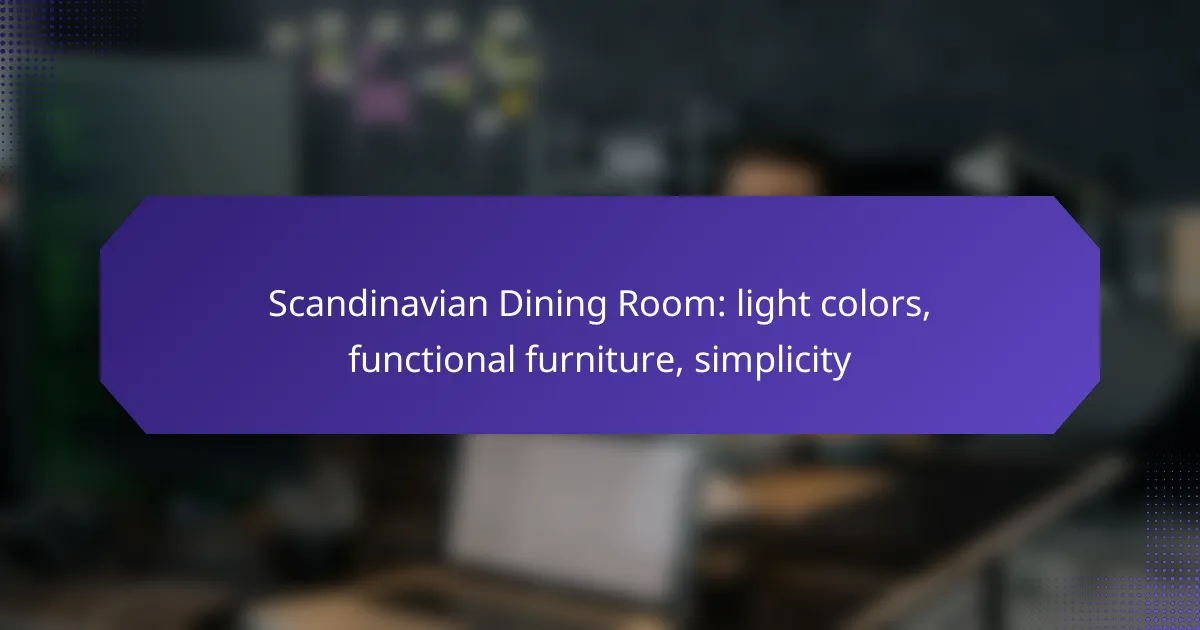Transforming your dining room into a Scandinavian oasis involves embracing light colors, functional furniture, and a commitment to simplicity. This design philosophy prioritizes minimalism and practicality, making it perfect for any dining space. By selecting airy, versatile pieces, you can create an inviting atmosphere that reflects the essence of Scandinavian style.

How to create a Scandinavian dining room in Canada?
Creating a Scandinavian dining room in Canada involves using light colors, functional furniture, and a focus on simplicity. This design style emphasizes minimalism and practicality, making it ideal for both small and spacious dining areas.
Use light color palettes
Light color palettes are essential in Scandinavian design, as they create an airy and spacious feel. Opt for whites, soft grays, and pale pastels to enhance natural light and make the room feel larger. Consider using these colors on walls, furniture, and decor to maintain a cohesive look.
Accent colors can be introduced through accessories like tableware or artwork, but keep them subtle to preserve the overall lightness. Avoid dark colors that can make the space feel cramped or heavy.
Incorporate functional furniture
Functional furniture is a hallmark of Scandinavian design, focusing on practicality without sacrificing style. Choose dining tables and chairs that are not only aesthetically pleasing but also comfortable and easy to move. Look for pieces with built-in storage or multi-functional capabilities, such as extendable tables.
Materials like wood and metal are popular for their durability and timeless appeal. When selecting furniture, ensure it complements the light color scheme and fits the scale of your dining area.
Emphasize simplicity in design
Simplicity is key in Scandinavian dining room design. Aim for clean lines and uncluttered spaces to foster a sense of calm. Avoid overly ornate decorations and instead focus on essential items that serve a purpose.
When decorating, choose a few statement pieces, such as a unique light fixture or a simple centerpiece, to draw attention without overwhelming the space. Strive for balance and harmony in your design choices.
Utilize natural materials
Natural materials play a significant role in Scandinavian design, contributing to a warm and inviting atmosphere. Incorporate wood, stone, and textiles like linen or cotton to add texture and warmth to your dining room.
Consider using reclaimed wood for tables or chairs to enhance the rustic charm while being environmentally friendly. Natural fibers in rugs or curtains can also soften the space and add comfort.
Maximize natural light
Maximizing natural light is crucial for achieving the bright and airy feel characteristic of Scandinavian design. Use sheer curtains or blinds that allow light to filter in while maintaining privacy. Position mirrors strategically to reflect light and create the illusion of a larger space.
Keep window areas clear of heavy furniture or decor to ensure unobstructed light flow. If possible, opt for light-colored window frames to blend seamlessly with the overall design theme.

What are the best furniture options for Scandinavian dining rooms?
The best furniture options for Scandinavian dining rooms emphasize light colors, functional designs, and simplicity. Key pieces often include minimalist dining sets, stylish chairs, and versatile tables that enhance the airy feel characteristic of this design style.
IKEA dining sets
IKEA offers a range of dining sets that embody Scandinavian design principles with their clean lines and functional aesthetics. Popular options include the INGATORP and NORNA series, which feature light wood finishes and can easily fit into various dining spaces.
When selecting an IKEA dining set, consider the size of your dining area and the number of people you typically host. Many sets come with extendable options, making them practical for both everyday use and larger gatherings.
Muuto chairs
Muuto chairs are known for their modern yet timeless designs, often incorporating soft colors and natural materials. Models like the Fiber Chair and Stacked Chair provide comfort while maintaining a minimalist look that complements Scandinavian dining rooms.
Choose Muuto chairs that match your dining table’s height and style. Their lightweight construction allows for easy rearrangement, making them ideal for flexible dining arrangements.
HAY tables
HAY tables are celebrated for their innovative designs and functionality, often featuring a mix of materials that enhance their aesthetic appeal. The CPH Table and Tray Table are excellent examples that blend practicality with a sleek Scandinavian look.
When selecting a HAY table, consider the surface area and shape that best suits your dining needs. Round tables can create a more intimate setting, while rectangular options are great for larger spaces. Ensure the table height is compatible with your chosen chairs for a cohesive dining experience.

What are the key characteristics of Scandinavian design?
Scandinavian design is defined by its emphasis on simplicity, functionality, and light colors. This style prioritizes minimalism and natural materials, creating spaces that are both aesthetically pleasing and practical.
Minimalism
Minimalism in Scandinavian design focuses on reducing clutter and emphasizing clean lines. Furniture and decor are often streamlined, with a preference for open spaces that promote a sense of calm. This approach encourages the use of fewer, high-quality pieces rather than an abundance of items.
To achieve a minimalist look, consider using a neutral color palette with light shades such as whites, grays, and soft pastels. Avoid ornate decorations and instead opt for functional items that serve a purpose while maintaining an elegant appearance.
Functionality
Functionality is a cornerstone of Scandinavian design, where every piece of furniture is designed to be practical and versatile. Multi-functional furniture, such as sofas that convert into beds or tables with built-in storage, is common in these spaces.
When selecting furniture, prioritize items that maximize utility without sacrificing style. Look for pieces that can adapt to various needs, making your dining room not just a place to eat, but also a space for work or relaxation.
Natural elements
Incorporating natural elements is essential in Scandinavian design, which often features wood, stone, and textiles that evoke a connection to nature. Light woods like birch or pine are frequently used for furniture, while natural fibers in textiles add warmth and texture.
To enhance this aspect, consider adding plants or natural decor items to your dining room. These elements not only improve air quality but also create a serene atmosphere that complements the overall design ethos.

How to choose the right lighting for a Scandinavian dining room?
Choosing the right lighting for a Scandinavian dining room involves selecting fixtures that enhance the space’s light colors and functional design. Focus on simplicity and warmth to create an inviting atmosphere that complements the minimalist aesthetic.
Opt for pendant lights
Pendant lights are a popular choice in Scandinavian dining rooms due to their ability to provide focused illumination while adding a stylish element. Hang them above the dining table to create a central focal point that draws the eye and enhances the room’s functionality.
When selecting pendant lights, consider designs that feature clean lines and natural materials, such as wood or metal. A cluster of smaller pendants can also add visual interest while maintaining the simplicity characteristic of Scandinavian design.
Choose warm LED bulbs
Warm LED bulbs are essential for achieving the cozy ambiance typical of Scandinavian interiors. Opt for bulbs with a color temperature around 2700K to 3000K, which emit a soft, inviting glow that complements light-colored walls and furniture.
Additionally, using dimmable LED bulbs allows for flexibility in lighting levels, enabling you to adjust the brightness based on the time of day or occasion. This adaptability enhances the functionality of your dining space while maintaining a warm atmosphere.
Incorporate floor lamps
Floor lamps can serve as both functional lighting and decorative accents in a Scandinavian dining room. Position them in corners or near seating areas to provide additional light and create a layered lighting effect that enhances the room’s overall design.
Choose floor lamps with simple, elegant designs that align with the minimalist aesthetic. Look for options that feature natural materials or neutral colors to ensure they blend seamlessly into the space while adding warmth and comfort.

What are the popular color schemes for Scandinavian dining rooms?
Scandinavian dining rooms often feature light color schemes that emphasize simplicity and functionality. Popular choices include combinations of white and gray, pastel accents, and earthy tones, all contributing to a serene and inviting atmosphere.
White and gray combinations
White and gray combinations are a hallmark of Scandinavian design, creating a clean and airy feel. These neutral shades work well together, allowing for flexibility in furniture and decor choices. Consider using a soft gray on walls paired with white furniture to maintain brightness while adding depth.
To enhance this palette, incorporate natural materials like wood or metal accents. This contrast can add warmth and texture, making the space feel more inviting without overwhelming the minimalist aesthetic.
Pastel accents
Pastel accents can bring a touch of color to a predominantly neutral Scandinavian dining room. Soft hues like pale pink, mint green, or light blue can be introduced through accessories such as tableware, cushions, or artwork. These subtle colors maintain the lightness of the space while adding personality.
When using pastels, balance them with white or gray to prevent the room from feeling cluttered. A few well-placed pastel items can create focal points without detracting from the overall simplicity of the design.
Earthy tones
Earthy tones, such as muted greens, browns, and terracotta, can add warmth and a connection to nature in Scandinavian dining rooms. These colors work well with natural wood furniture and can be used in wall paint or decorative elements. They create a cozy atmosphere that complements the functional aspects of Scandinavian design.
Incorporating plants can enhance the earthy palette, bringing life and freshness into the space. Choose pots in natural materials to maintain cohesion with the overall aesthetic, ensuring that the earthy tones harmonize with the light color schemes typical of Scandinavian interiors.

How to accessorize a Scandinavian dining room?
Accessorizing a Scandinavian dining room involves selecting items that enhance its light, functional, and simplistic aesthetic. Focus on natural materials, neutral colors, and minimalistic designs to create a cohesive look.
Choose natural materials
In Scandinavian design, natural materials like wood, stone, and textiles play a crucial role. Opt for wooden dining tables and chairs that showcase their grain, or incorporate stone elements through table centerpieces or serving dishes. Textiles such as linen or cotton can add warmth without overwhelming the space.
Incorporate light colors
Light colors are essential in a Scandinavian dining room to maintain an airy feel. Whites, soft grays, and muted pastels can be used on walls, furniture, and accessories. Consider using light-colored tableware and decorative items to complement the overall palette.
Focus on functional decor
Functional decor is key in Scandinavian design, where every piece serves a purpose. Choose items like stylish storage solutions, practical tableware, and multi-functional furniture. For example, a bench with storage can provide seating while keeping the space organized.
Keep it minimal
Minimalism is a hallmark of Scandinavian style, so avoid cluttering the dining area with excessive decorations. Select a few well-chosen accessories, such as a simple vase or a piece of art, to create focal points without overwhelming the space. Aim for balance and harmony in your selections.










